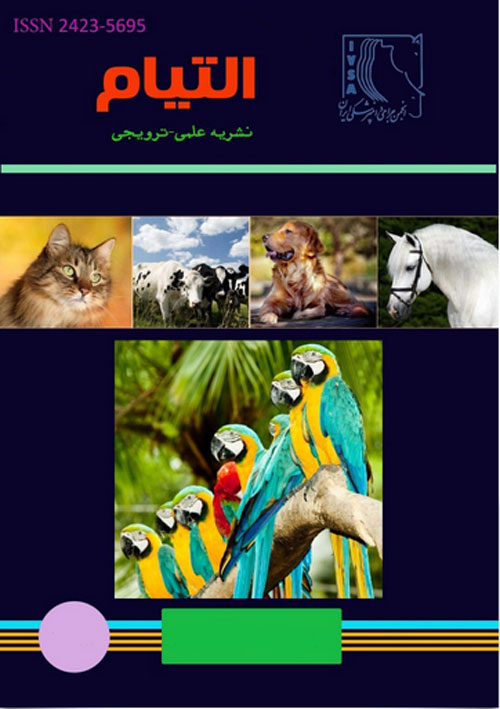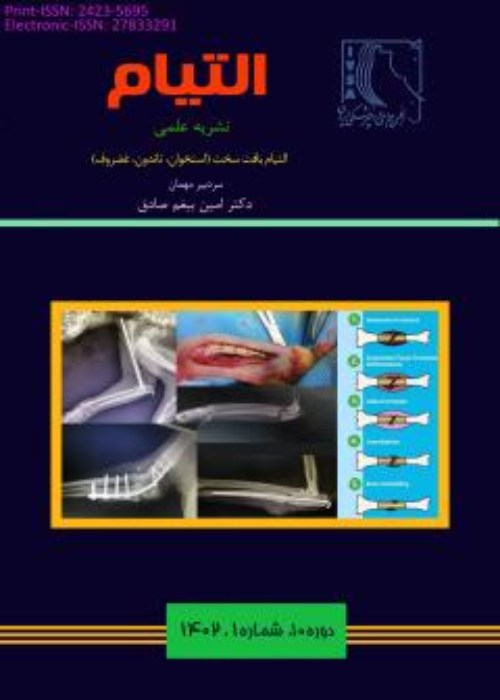فهرست مطالب

نشریه التیام
سال سوم شماره 5 (پاییز و زمستان 1395)
- تاریخ انتشار: 1395/12/15
- تعداد عناوین: 5
-
-
صفحه 18
-
Page 4Ostrich breeding is considered as a growing industry in Iran. Due to its increasing development, the industry's need for health and veterinary services is inevitable. Industrial Ostrich raising, like other animal species, has made it necessary to pay attention to some surgical skills such as anesthetic protocol to address some of the problems including complications of gastrointestinal, motor limbs and other. In this paper, we have tried to provide regular and coherent information on preanesthetic, anesthetics drugs and their consumption in ostriches.Keywords: Ostrich, Anesthetic, pre-Anesthetic, Sedative
-
Page 11Restraint is requiring for clinical examination and treatment on birds like others animals. Both physical and chemical restraint can be used in birds. In surgical procedures on birds sedation and analgesia are important. Because mammals have different anatomy and physiology, there are limitations to the use of common anesthesia techniques in avian anesthesia. Inhalation anesthesia is the veterinarians method of choice that has many advantages such fast induction of anesthesia and recovery from anesthesia. Ease of use in the field and Wildlife, better speed of induction of anesthesia, the need for minimal equipment and low cost are some advantages for injectable anesthesia. One disadvantage of this method is elimination of drug from body that is dependent on biotransformation and excretion. For avian anesthesia, according to species, type of surgical procedure, duration of anesthesia and sedation and availability of equipment, the best method of anesthesia and least dangerous should be chosen and used.Keywords: Anesthesia, Birds, Inhalation anesthesia, Injectable anesthesia
-
Page 18Shock is the end stage or final common path of many diseases. We commonly think that shock is an event that follows severe hemorrhage or endotoxemia and causes tachycardia, tachypnea, hypotension, depression, stupor, coma, dehydration and abnormal mucous membranes. These clinical signs may be associated with shock and are easily recognized, but they are common to many other condition. The clinical signs of shock reflect hemodynamic responses that are the result of exquisitely controlled neurohumoral mechanisms triggered by depletion of effective circulating volume. Shock can be defined as an imbalance between oxygen delivery and oxygen consumption. Because oxygen is not stored in tissues, the rate of oxygen uptake from the capillaries must match the metabolic requirements of the tissues for aerobic metabolism to continue. When metabolic demand for oxygen exceeds the rate of oxygen uptake by the tissues, anaerobic metabolism ensues, resulting in decreased energy production. When cell dysoxia produces a measurable change in organ function, the condition is commonly known as shock. If it left untreated, progressive tissue hypoxia leads to altered cellular metabolism, cell death, organ failure, and, ultimately, the death of the animal.Keywords: Shock, Neurohumoral, Circulating volume, Oxygen, Metabolism
-
Page 27Intra-abdominal adhesion is one of the most important post-surgical complications in pelvic and abdominal operations. They occur after 50% to 100% of all surgical intervention in abdomen and can cause intestinal obstruction (partial/complete), female infertility and chronic abdominal pain. There is a lack of clinically oriented guidelines for the diagnosis, treatment and options for reduction of adhesions. Against that backdrop this article sets out to:● Increase clinicians awareness of adhesions and their consequences
● Offer an overview of the pathogenesis of adhesions
● Describe universally applicable and readily implemented strategies to reduce the occurrence of adhesions
● Introduce commercial products for reduction of adhesions.Keywords: Post-operative adhesion, Complications, Prevention -
Page 34Occurrence of Inflammation process is a vital response induced by immune system for muscle repair. Following of muscular damage in traumatic wounds, immune system may play an important role in rehabilitation and repair of muscular and surrounding connective tissue. Aggregation of destructional proteins may initiate inflammatory responses which would be similar to acute phase reactions. Regulation of immune responses to muscular damage and inflammation is modulated by special messengers named cytokines including MCP-1. Increased activity of Keratin kinase and Lactate dehydrogenase values considered laboratory signals of muscular destructions. Additionally, leukocytes are participating in rehabilitation and repair of muscular damage. Therefore, the severity of immune reactions and inflammatory responses after muscular damage and also repair process would be assessed by leukocyte count, inflammatory markers and presenting cytokines in the blood. The aim of this study was to evaluate the immune and leukocyte responses in inflammation and repair process in macular traumatic wounds in dogs. To this point, 6 number of dogs with ulcer and traumatic wounds were selected, serum inflammatory and muscular markers and leukocyte changes were studied in the first referral and after wound repair. The results showed that neutrophilic leukocytosis and lymphocytosis, significant increase of cortisol level and MCP-1, CPK and LDH were observed in traumatic wounds. After tissue repair, CPK and LDH were returned to the basic value and leukocyte changes were found as monocytosis and slight leukocytosis and MCP1 value climbed markedly compared to the first referral. It would be concluded that released factors in the time of muscular damage and inflammation were not accelerated after performing appropriate treatment and repair and measurement of MCP-1 values would be helpful in determination of active repair process.Keywords: Dog, Muscular traumatic wound, Inflammatory markers


